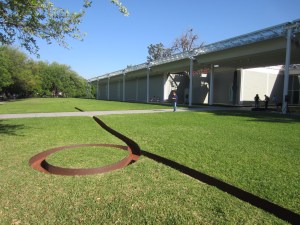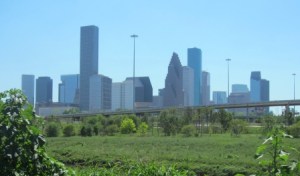Up at 7:30, bikes on the car, then onto Highway 10 for a nostalgia excursion to Galveston, the affordable beach getaway for my family years ago.
 Galveston is essentially a barrier island – every few decades the island is scoured by hurricane winds and storm surge waves – the most recent being Hurricane Ike in 2008. It is amazing how much that is old and charming has survived the gales and sea water. Three major storms have attacked the island since I visited it as a child, yet it seemed much more lovely than my memories. We cruised the island on our bikes under sunny blue skies, beginning in the Strand area, which is the oldest part of downtown. We saw lots of brick store-fronts and wrought – iron balconies a la New Orleans, and dating to the same period. This part of town was probably much too seedy for me and my family in earlier years; it has been spruced up with bright paint, murals, jazz clubs, restaurants, and a family-friendly trolley line a’ la New Orleans also.
Galveston is essentially a barrier island – every few decades the island is scoured by hurricane winds and storm surge waves – the most recent being Hurricane Ike in 2008. It is amazing how much that is old and charming has survived the gales and sea water. Three major storms have attacked the island since I visited it as a child, yet it seemed much more lovely than my memories. We cruised the island on our bikes under sunny blue skies, beginning in the Strand area, which is the oldest part of downtown. We saw lots of brick store-fronts and wrought – iron balconies a la New Orleans, and dating to the same period. This part of town was probably much too seedy for me and my family in earlier years; it has been spruced up with bright paint, murals, jazz clubs, restaurants, and a family-friendly trolley line a’ la New Orleans also.
Down one brick-paved street loomed the huge Art Deco train station dating to the days when Galveston was the largest port in Texas; down another loomed an equally bulky Carnival cruise ship. The harbor was hosting myriad types of maritime vessels, including Elissa, “Texas’s Tall Ship”, a couple of oil barges, the Carnival Cruise ship, and an oil drilling platform moored at its own dock and turned into a museum courtesy of Exxon.
Then through an older neighborhood of beautifully maintained Victorians in candy colors over to the Sea Wall – a huge wide expanse of avenue, concrete seawall, and beach which stretches 10 miles along the 27-mile long island. The seawall was built in response to the Great Storm of 1900, when 15-foot waves had inundated the island and killed over 8000 people – still the deadliest natural disaster in US history.
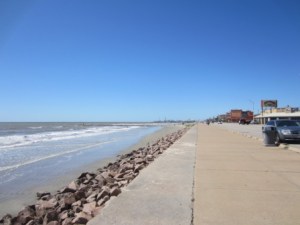 The pieces missing from my childhood memory were the tourist piers which had stretched out into the water offering all sorts of shells, shirts, and other souvenirs. There were lots of pilings, but only one pier, and that one reaching in a tentative curve rather than the long fingers I remembered. Then we came to a historical marker – here is where Murphy’s famous pier was, before Ike. Everything I remembered had been swept away by Ike’s 20-ft storm surge, which swept over the seawall and engulfed the island. But Galvestonians are tenacious: the old Galvez Hotel sported fresh landscaping, and at the far end of the seawall a new Playland is under construction.
The pieces missing from my childhood memory were the tourist piers which had stretched out into the water offering all sorts of shells, shirts, and other souvenirs. There were lots of pilings, but only one pier, and that one reaching in a tentative curve rather than the long fingers I remembered. Then we came to a historical marker – here is where Murphy’s famous pier was, before Ike. Everything I remembered had been swept away by Ike’s 20-ft storm surge, which swept over the seawall and engulfed the island. But Galvestonians are tenacious: the old Galvez Hotel sported fresh landscaping, and at the far end of the seawall a new Playland is under construction.
Evidence of the devastation of Ike is everywhere if you begin to look. Live oaks that were planted after the Great Storm of 1900 and survived both the Pretty Big Storm of 1915 and Hurricane Carla were poisoned by the saltwater of Ike’s tidal surge. Some local artists carved the remains into shapes of mermaids, dolphins, egrets, etc. – these spontaneous artworks are now a tourist attraction. Many buildings still show the scars of watermarks at chest level or higher.
After lunch at the Saltwater Grill in the Strand area we walked to a quilt exhibit in the adjacent Federal Customs Office, now a museum in process of restoration. Another easy walk through historic neighborhoods took us to the “Bishop’s Castle” – one of the huge piles of Texas granite and Sandstone which has been preserved from the wreckers along Broadway – formerly the elegant center of town.
 This home, built for a local railroad lawyer and his family of four boys and three girls, was a Statement Home in its day, each room featuring a different exotic wood, each fireplace a different exotic granite, each window topped with glowing stained glass. Imagine a family of nine – Mom and Dad shared a master bath, and all seven children shared the second bath. The five servants plus the nanny shared the servant’s bath in the basement. I was imagining a Galvestonian version of “Upstairs Downstairs” – it would be fun to write!
This home, built for a local railroad lawyer and his family of four boys and three girls, was a Statement Home in its day, each room featuring a different exotic wood, each fireplace a different exotic granite, each window topped with glowing stained glass. Imagine a family of nine – Mom and Dad shared a master bath, and all seven children shared the second bath. The five servants plus the nanny shared the servant’s bath in the basement. I was imagining a Galvestonian version of “Upstairs Downstairs” – it would be fun to write!
The house was abandoned after the storm of 1915 and Galveston’s subsequent slide from an elegant port city to a “sin city” dominated by gambling and prostitution. Fortunately, the house is located across from the Catholic cathedral; the church bought the home at a tenth of its building cost as a residence for the bishop, hence its salvation from the wreckers. The Bishop had one bedroom converted to a chapel, replaced a rather racy stained-glass window with one depicting St. Theresa, and made himself at home.
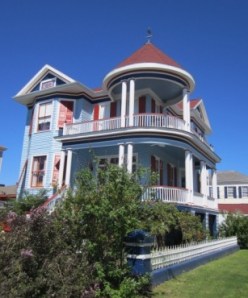 My KF had secured a tape of the documentary “Voices of the Storm” – a Ken Burns -style documentary of the Great Storm of 1900 as told through letters and oral histories, illustrated by old photos and etchings. Every place has its history, every history has its stories to discover or imagine. I’m thinking – how to describe Galvestonians, this friendly group clinging to their barrier reef, restoring and rebuilding again and again? They might call themselves tenacious, loyal, deeply-rooted. I suspect their insurance agents might use a different set of adjectives – say… mulishly stubborn? Unable to learn from experience? Fighting a losing battle against Nature?
My KF had secured a tape of the documentary “Voices of the Storm” – a Ken Burns -style documentary of the Great Storm of 1900 as told through letters and oral histories, illustrated by old photos and etchings. Every place has its history, every history has its stories to discover or imagine. I’m thinking – how to describe Galvestonians, this friendly group clinging to their barrier reef, restoring and rebuilding again and again? They might call themselves tenacious, loyal, deeply-rooted. I suspect their insurance agents might use a different set of adjectives – say… mulishly stubborn? Unable to learn from experience? Fighting a losing battle against Nature?
On a beautiful blue-skied day, with the restored Victorian trim sparkling in the sun, it is hard not to love the termerity and audacity of these islanders .
.



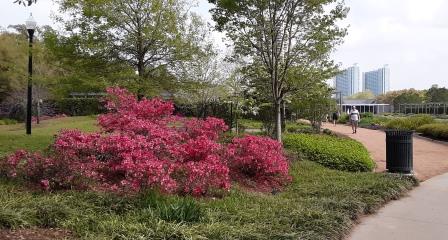




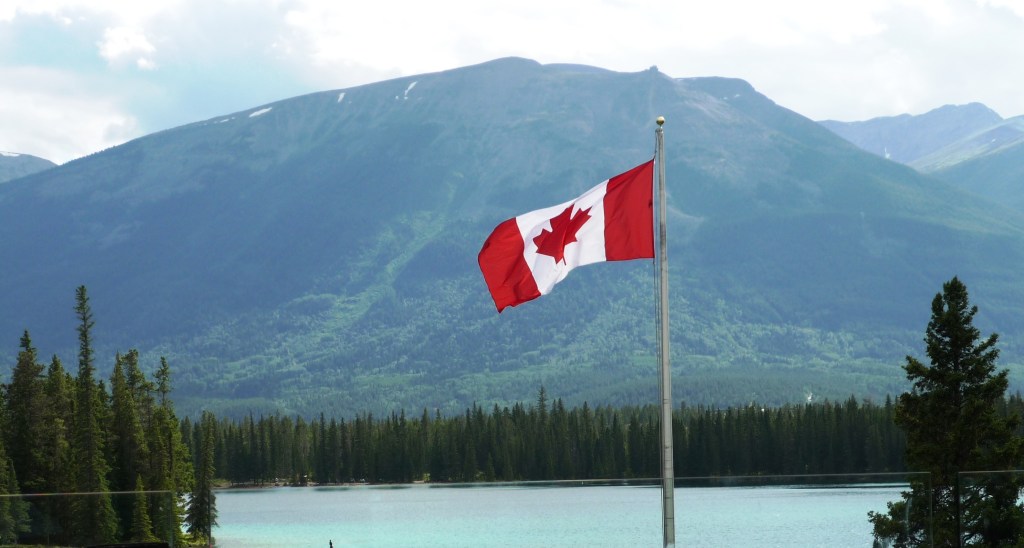










 My KF had secured a tape of the documentary “Voices of the Storm” – a Ken Burns -style documentary of the Great Storm of 1900 as told through letters and oral histories, illustrated by old photos and etchings. Every place has its history, every history has its stories to discover or imagine. I’m thinking – how to describe Galvestonians, this friendly group clinging to their barrier reef, restoring and rebuilding again and again? They might call themselves tenacious, loyal, deeply-rooted. I suspect their insurance agents might use a different set of adjectives – say… mulishly stubborn? Unable to learn from experience? Fighting a losing battle against Nature?
My KF had secured a tape of the documentary “Voices of the Storm” – a Ken Burns -style documentary of the Great Storm of 1900 as told through letters and oral histories, illustrated by old photos and etchings. Every place has its history, every history has its stories to discover or imagine. I’m thinking – how to describe Galvestonians, this friendly group clinging to their barrier reef, restoring and rebuilding again and again? They might call themselves tenacious, loyal, deeply-rooted. I suspect their insurance agents might use a different set of adjectives – say… mulishly stubborn? Unable to learn from experience? Fighting a losing battle against Nature?


